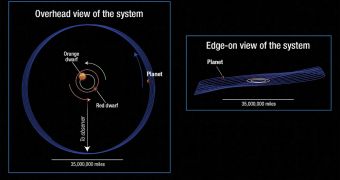A team of astronomers was recently able to use data collected by the NASA Kepler Space Telescope to detect an extrasolar planet that displays extremely unusual orbital parameters. Observations show that the world wobbles significantly around its axis as it orbits its parent stars.
This most likely leads to extreme seasons, which succeed each other erratically over the course of a year. For all intents and purposes, the planet resembles a spinning top as it swirls around its stars. If humans were to live there, deciding between shorts and a thick fur coat on any given day would be impossible.
Kepler studies have revealed that the exoplanet's axis can tilt by up to 30 degrees over an 11-year period. By comparison, Earth's axial tilt is roughly 23 degrees, which enables relatively moderate seasons and contributes to a steady climate. Our planetary tilt changes once every 26,000 years.
The new exoplanet was found around a binary star system called Kepler-413 and was dubbed Kepler-413b. The system lies around 2,300 light-years away in the constellation Cygnus (The Swan). Kepler-413 is made up of an orange dwarf and a red dwarf, which orbit each other every 66 days.
Another interesting aspect of the planet's orbit is that it is inclined at a 2.5-degree angle with respect to the binary system's plane. In our solar system, all planets revolve within this plane, with the notable exception of Pluto, which is slightly off.
From our vantage point, Kepler-413b's orbit appears to wobble, or precess, up and down continuously. Kepler was able to notice this pattern by analyzing how the binary system's brightness changed over time. Whenever an exoplanet passes in front of its parent star, it causes the latter to lose a little bit of brightness, and this telescope is able to pick up these minute variations.
“Looking at the Kepler data over the course of 1,500 days, we saw three transits in the first 180 days – one transit every 66 days – then we had 800 days with no transits at all. After that, we saw five more transits in a row,” says researcher Veselin Kostov.
The expert, who is based at the Space Telescope Science Institute (STScI) and the Johns Hopkins University (JHU) in Baltimore, Maryland, was the principal science investigator for the observations.
“Presumably there are planets out there like this one that we're not seeing because we're in the unfavorable period. And that's one of the things that Veselin is researching: Is there a silent majority of things that we're not seeing?” comments STScI/JHU team member Peter McCullough.

 14 DAY TRIAL //
14 DAY TRIAL //